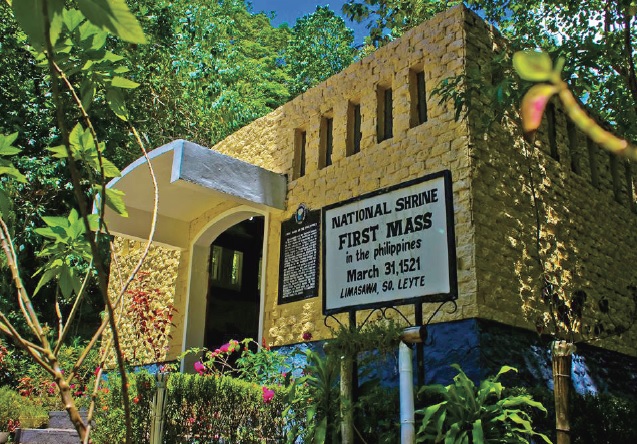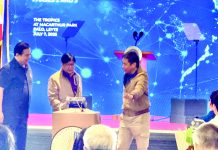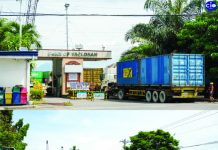
BY: RONALD O. REYES/JOEY A. GABIETA
TACLOBAN CITY- It is in Limasawa.
Thus said the National Historical Commission of the Philippines (NHCP) as it reaffirmed its earlier ruling that the country’s First Mass held 499 years ago was in Limasawa, Southern Leyte and not in Butuan.
The NHCP released its ruling on Wednesday (August 19) though its board commissioners made the decision on July 15, 2020.
Limasawa Mayor Melchor Petracorta said that this latest decision of the NHCP would finally bury to rest the dispute as to where the First Mass in the country was really held.
And what makes the decision more significant is that, it came at a time as their town will be celebrating its founding anniversary on August 27, he said.
“We are jubilant with this decision of the NHCP.And we hope this settles the issue with finality and the decision came at a right time as we are to celebrate our 37th founding anniversary. It’s a really a gift for us the people of Limasawa,” Petracorta said in a phone interview.
Mayor Petracorta said that the decision of the NHCP ‘is not only a victory of Limasawa but for the entire Eastern Visayas region.’
This decision was also welcome by the Diocese of Maasin saying they were right on their claim that Limasawa, which is part of the diocese, was the site of the first Mass.
Fr. Johnrey Sibi, head of the Limasawa Commission of the diocese, said that they were ‘very happy’ on this NHCP ruling.
“The reaffirmation of the NHCP inspires us to work hard for the celebration that will not only echo in our place but nationally as it has a national heritage,” Sibi, in a phone interview, said, adding that the decision was a ‘concrete affirmation’ where the Christianity in the country actually started.
Monsignor Oscar Cadayona also expressed his elation over the official government declaration, saying: “We are so happy that our proofs – of the veracity of our claims that our Limasawa is really the site – were not dismantled by those who supported other sites.”
“It really inspires us, the Bishop, clergy and the lay faithful to work hard to promote the site as a sacred place of encounter between God and man. With this development, we are optimistic that the Filipino people will rally behind us as we build structures there as concrete signs of gratitude to the Almighty for the gift of faith received in Limasawa,” he said.
The town officials of Limasawa, together with the Diocese of Maasin, has been busy preparing for the 500th year anniversary of the historical event next year.
For local historian Rolando Borrinaga, the decision was a ‘sweet vindication’ as he, among others, claimed that the country’s first Mass held on March 21,1521 was held in Limasawa and not in Butuan.
The commission also agreed with Borrinaga that the rightful place of the first Mass was in Barangay Triana and not in Brgy. Magallanes, where the annual celebration is being held.
“The decision of the NHCP provides sweet vindication for my research and advocacy that the 1521 Easter Sunday Mass was held in the vicinity of Triana in western Limasawa, Southern Leyte and not in Butuan in Mindanao,” he said.
Borrinaga said that pro-Butuan group, while insisting that the historic event was held on their place, did not presented any new arguments in ‘terms of period documentation.’
The NHCP, on its report on the dispute, said that based on the evidences presented and the research they have conducted, the first Mass was in Limasawa and not in Butuan.
“The panel has concluded that, based on the evidence presented and the research it has conducted in aid of the evaluation, the evidence and arguments presented by the pro-Butuan proponents, while commendably serious and substantial, are not sufficiently conclusive to demand a repeal or reversal of the current government ruling on the case of the First Easter Sunday Mass. The panel therefore recommends that Limasawa Island, (Southern) Leyte, be sustained as the site of the First Easter Sunday Mass of 1521,” it said.
It, however, said that despite of their adverse finding, Butuan should still be recognized as a ‘precolonial trading center and base of the Christianization of Mindanao.’
Dr. Rene Escalante, chairman of NHCP and executive director of the National Quincentennial Committee, said they revisited the issue surrounding the site of the 1521 Easter Sunday Mass in the Philippines as part of its mandate to resolve historical controversies.
He cited Antonio Pigafetta, the chronicler of the Magellan-Elcano expedition, who wrote that the first mass happened on March 31, 1521 in a place he identified as Mazaua.
In a seven-page statement, Escalante disclosed that the issue as to the exact location of the First Catholic Mass was resolved by the forerunner of the NHCP, the National Historical Institute (NHI), through two panels of experts: the first headed by former Supreme Court Justice Emilio Gancayco (1995) and the second by historian Dr. Benito J. Legarda (2008).
Both panels ruled that the site of the 1521 Easter Sunday Mass was in Limasawa Island, now a municipality in Southern Leyte, he said.
However, the reopening of the historical controversy happened in 2018 when NHCP “received a number of requests from various institutions, including the Catholic Bishops Conference of the Philippines, to reexamine the earlier decisions of the NHI.”
“These requests were made in the light of some claims that there were new primary sources and evidences that surfaced recently which were not taken into consideration by the previous panels. NHCP also saw the necessity of reopening a new inquiry because of the forthcoming commemoration of the 500th anniversary of the introduction of Christianity in the Philippines in 2021,” the commission added.
In November 2018, the commission created a new panel of experts “who reexamined the historical controversy and reviewed the findings of the previous panels for a year.”
The Mojares panel includes national and globally-recognized historians, paleographers, and translators, and CBCP representative: Dr. Danilo Gerona (Partido State University), Dr. Francis Navarro (Ateneo de Manila University), Dr. Carlos Madrid Álvarez-Piñer (University of Guam), and Fr. Antonio Francisco de Castro, SJ (Loyola School of Theology, representing CBCP), with historian Dr. Jose Victor Torres (De La Salle University) as the panel’s Secretary-General.
Aside from Fr. de Castro, CBCP was also represented by other church historians as observers of the panel’s proceedings like Fr. Milan Ted Torralba (CBCP Episcopal Commission for the Cultural Heritage of the Church); Fr. Emil Quilatan, OAR (Archivist, Augustinian Recollect Archives); Fr. Amado Tumbali, SJ (Archivist, Archives of the Philippine Province of the Society of Jesus); Fr. Antolin Uy, SVD (historian), and Fr. Albert Flores (Archivist, Manila Archdiocesan Archives and Museum).
According to the commission, no one in the panel came from either Agusan del Norte or Southern Leyte “so that their decision would be based primarily on evidence and sound analysis, and not on regional or territorial biases.”
The panel used primary and secondary sources, including high-resolution digital copy of the extant Pigafetta manuscripts from foreign institutions, to back its research.
They traveled to the actual contested areas in Butuan and Limawasa and listened to the two proponents as they presented their evidences and arguments to support their claims.
However, in its conclusion, the panel unanimously agreed that the evidences and arguments presented by the pro- Butuan advocates led by Dr. Potenciano Malvar and Gabriel Atega are not sufficient and convincing enough to warrant the repeal or reversal of the ruling on the case by the NHI.
Hence, the panel recommended that Limasawa Island, Southern Leyte, be sustained as the site of the 1521 Easter Sunday Mass, according to the commission, citing the official panel report.



